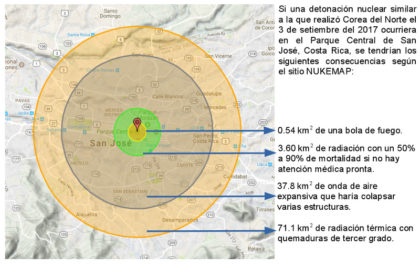
Seismic engineering laboratory of the UCR
On Sunday, North Korea conducted its sixth nuclear trial, which it described as “successful”. This was the most powerful of all and they claimed to have tested a hydrogen bomb.
The blast generated a 6.3-degree tremor in that area and was felt in China and South Korea. In addition, the action was condemned by the international community.
But what would happen in Costa Rica if a similar detonation were made?
The Laboratory of Seismic Engineering of the University of Costa Rica (LIS-UCR), made the estimates of the consequences, in case of an explosion of this type in Parque Central, San José.
In the Facebook page of LIS, a picture shows what we would face: a fireball at 0.54 km², radiation would reach 3.60 km² with a mortality from 50% to 90% if there is no timely medical care.
The expansive airwave, which would collapse several structures would be 37.8 km², the thermal radiation would cause third degree burns and it would cover 71.1 km².
The North Korean explosion was quickly condemned by China, Russia, Japan, South Korea and France, responding to a new violation of the many United Nations (UN) resolutions calling for the end of nuclear and ballistic programs in North Korean.
US President Donald Trump issued a threat of a “massive military response” and warned all countries doing business with Pyongyang.
According to information shared by the LIS, since the first nuclear trial on July 15th, 1945, more than 2,051 nuclear weapons trials have been carried out around the world.
On October 30th, 1961, the USSR detonated the largest nuclear weapon ever tested and created the largest artificial blast in history. The explosion was 3,000 times stronger than the bomb used in Hiroshima. It broke windows 560 miles (901 km) away. The blast of light was visible up to 620 miles (997 km) away.